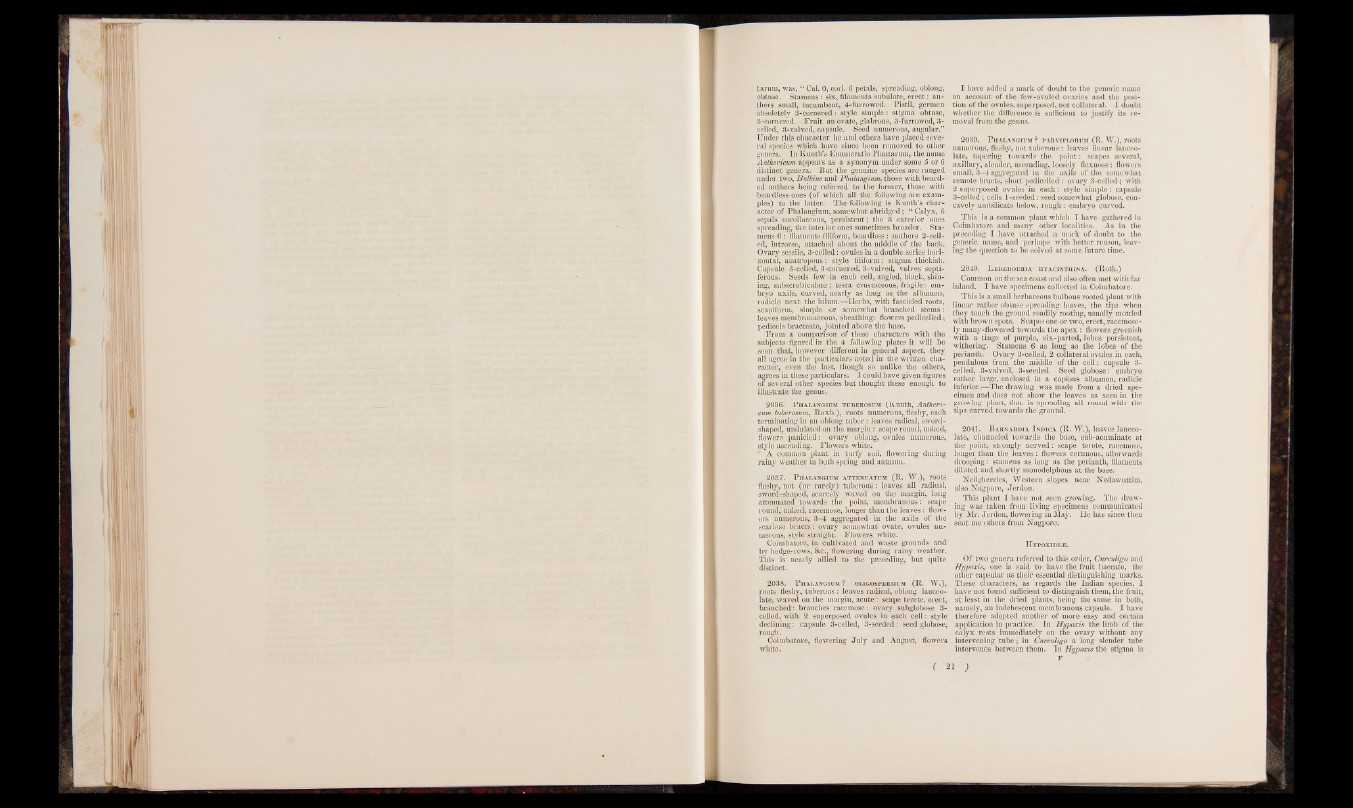
tarum, was, “ Cal. 0, corl. 6 petals, spreading, oblong,
obtuse. Stamens : six, filaments subulate, ere c t: anthers
small, incumbent, 4-furrowed. Pistil, germen
obsoletely 3-cornered: style simple: stigma obtuse,
3-cornered. Fruit an ovate, glabrous, 3-furrowed, 3-
eelled, 3-valved, capsule. Seed numerous, angular.”
Under this character he and others have placed several
species which have since been removed to other
genera. In Kuuth’s Euumeratio Plantarum, the name
Anlhericum appears as a synonym under some 5 or 6
distinct genera. But the genuine species are ranged
under two, Bulbine and Phalangium, those with bearded
anthers being referred to the former, those with
beardless ones (of which all the following are examples)
to the latter. The following is Kunth’s character
of Phalangium, somewhat abridged; “ Calyx, 6
sepals corollaceous, persistent; the 3 exterior oups
spreading, the interior ones sometimes broader. Stamens
6: filaments filiform, beardless: anthers 2-cell -
ed, introrse, attached about the middle of the back.
Ovary sessile, 3-celled: ovules in a double series horizontal,
anatropous: style filiform: stigma thickish.
Capsule 3-celled, 3-cornered, 3-vaived, valves septi-
ferous. Seeds few in each cell, angled, black, shining,
subscrobiculate; testa crustaceous, fragile: embryo
axile, curved, nearly as long as. the albumen,
radicle next the hilura.—Herbs, with fascicled roots,
scapiform, simple or somewhat branched stems:
leaves membranaceous,, sheathing: flowers pedicelled;
pedicels bracteate, jointed above the base.
From a comparison of these characters with the
subjects figured in the 4 following plates it will be
seen that, however different in general aspect, they
all agree in the particulars noted in the written character,
even the last, though so unlike the others,
agrees in these particulars. I could have given figures
of several other species but thought these enough to
illustrate the genus.
2036. P halangium tuberosum (Kunth, Antheri-
cum tuberosum, Roxb.), roots numerous, fleshy, each
terminating in an oblong tu b e r: leaves radical, swordshaped,
undulated on the margin: scape round, naked,
flowers panicled: ovary oblong, ovules numerous,
style ascending. Flowers white.
*■ A common plant in turfy soil, flowering during
rainy weather in both spring and autumn.
2037. P halangium attenuatum (R. W.), roots
fleshy, not (or rarely) tuberous: leaves all radical,
sword-shaped, scarcely waved on the margin, long
attenuated towards the point, membranous: scape
round, naked, racemose, longer than the leaves: flowers
numerous, 3-4 aggregated in the axils of the
scariose bracts1: ovary somewhat ovate, ovules numerous,
style straight. Flowers white.
Coimbatore, in cultivated and waste grounds and
by hedge-rows, &c., flowering during rainy weather.
This is nearly allied to the preceding, but quite
distinct.
2038. P halangium ? oligospermum (R. W.),
roots fleshy, tuberous: leaves radical, oblong lanceolate,
waved on the margin, acute: scape terete, erect,
branched: branches racemose: ovary subglobose 3-
celled, with 2 superposed ovules in each cell: style
declining: capsule 3-celled, 3-seeded: seed globose,
rough. •
Coimbatore, flowering July and August, flowers
white.
I have added a mark of doubt to the generic name
on account of the few-ovuled ovaries and the position
of the ovules, superposed, not collateral. I doubt
whether the difference is sufficient to justify its removal
from the genus.
2039. P halangium ? parviflorum (R. W.), roots
numerous, fleshy, not tuberous: leaves linear lanceolate,
tapering towards the point: scapes several,
axillary, slender, ascending, loosely flexuose: flowers
small, 3-4 aggregated in the axils of the somewhat
remote bracts, short pedicelled: ovary 3-celled; with
2 superposed ovules in each: style simple: capsule
3-celled; cells 1-seeded: seed somewhat globose, con-
cavcly umbilicate below, rough : embryo curved.
This is a common plant which I have gathered in
Coimbatore and many other localities. As in the
preceding I have attached a mark of doubt to the
generic name, and perhaps with better reason, leaving
the question to be solved at some future time.
2040. L edebouria hvacinthina. (Roth.)
Common on the sea coast and also often met with far
inland. I have specimens collected in Coimbatore.
This is a small herbaceous bulbous rooted plant with
linear rather obtuse spreading leaves, the tips when
they touch the ground readily rooting, usually mottled
with brown spots. Scapes one or two, erect, racemose-
ly many-flowered towards the ap e x : flowers greenish
with a tinge of purple, six-parted, lobes persistent,
withering. Stamens 6 as long as the lobes of the
perianth. Ovary 3-celled, 2 collateral ovules in each,
pendulous from the middle of the cell: capsule 3-
celled, 3-valved, 3-seeded. Seed globose: embryo
rather large, enclosed in a copious albumen, radicle
inferior.—The drawing was made from a dried specimen
and does not show the leaves as seen in the
growing plant, that is spreading all round with the
tips curved towards the ground.
2041. B arnardia I ndica (R. W.), leaves lanceolate,
channeled towards the base, sub-acuminate at
the point, strongly nerved: scape terete, racemose,
longer than the leaves: flowers cernuous, afterwards
drooping: stamens as long as the perianth, filaments
dilated and shortly monodelphous at the base.
Neilgherries, Western slopes near Nedawuttim,
also Nagpore, Jerdon.
This plant I have not seen growing. The drawing
was taken from living specimens Communicated
by Mr. Jerdon, flowering in May. He lias since then
sent me others from Nagpore.
H ypoxidle.
Of two genera referred to this order, Curcidigo and
Hypoxis, one is said to have the fruit baccate, the
other capsular as their essential distinguishing marks.
These characters, as regards the Indian species, I
have not found sufficient to distinguish them, the fruit,
at least in the dried plants, being the same in both,
namely, an indehescent membranous capsule. I have
therefore adopted another of more easy and certain
application in practice. In Hypoxis the limb of the
calyx rests immediately on the ovary without any
intervening tu b e; in Cnrculigo a long slender tube
intervenes between them. In Hypoxis the stigma is
F ( 21 fit